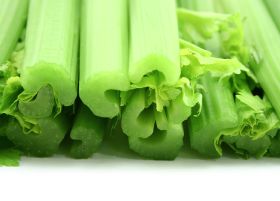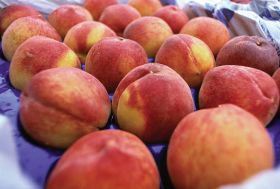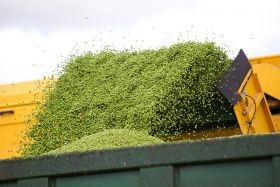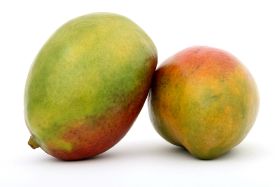
The FPJ Big 50 Products ranks the 50 best-selling fresh fruit and vegetable products by sales value, using Kantar Worldpanel data for the 52 w/e 20 May 2018.
36. Celery
Value: £68.8m (-1%) Volume 54m kg (+1.2%)

Bringing back customers key to growth
As a so-called ‘Marmite’ product, much of the focus in celery has been on encouraging those who love the vegetable to buy it more frequently. “We have been working hard to influence shoppers who are already buying the product to buy more often,” says G’s marketing director Anthony Gardiner.
The celery market remains steady, with value and volume sales staying more or less constant. However, with the exception of Italy, it is still one of the less developed fresh produce categories in most European markets.
One promising development is that more shoppers have been trading up from whole stalk celery to celery sticks, which continue to drive value into the market. Sales have been bolstered by the general trend for healthy snacking, with celery sticks increasingly used as an alternative to crisps or bread for dips such as hummus.
Celery giant G’s has also been involved in a food waste initiative with Tesco, using celery and various other produce in a ‘Waste Not’ range of ‘wonky’ juices. Priced at £1.50 per 250ml bottle, the range undercuts most other offerings on the cold press juice market and is sold in around 350 Tesco UK stores. Importantly, it helps G’s to derive value and reduce waste from its celery crop.
37. Peaches
Value: £60.5m (+7.1%) Volume: 35.5m kg (+7.1%)

Peach sales overcome turbulent year
After a challenging year for South African stonefruit, the peach statistics make handsome reading. A glut in Spain at the start of the 2017 season meant high volumes and lower prices, which in turn drove consumption, even if growers suffered from the discounted crop.
Dan Masters, commercial manager at Norton Folgate, explains: “Last season was difficult for the growers but it resulted in some amazing offers from the high street, which drove consumption.”
Once again the flat peach was the main driver of new growth. “They have been around for some time, but for some reason people are really latching onto them now. In the past four to five years they have really taken off. They market better and the retailers are giving them more time,” Masters says.
Despite plentiful supply from Spain, South Africa had one of its toughest-ever seasons, with drought conditions hitting the Western Cape in particular, compounded by other climatic events including hail, which caused some damage to the fruit on the trees. Yet volumes were able to remain up after careful handling and management of the crop, with promotional activity like the “Beautiful Country, Beautiful Fruit” campaign meaning volumes from South Africa didn’t suffer as badly as plums.
38. Peas
Value: £59.8m (+3.6%) Volume: 12.3m kg (+3.4%)

Peas simmering with potential
At great value, with a low price per kilo, but an appeal that struggles to reach young adults, peas register lower down the FPJ Big 50 despite being ubiquitous in British households.
Perhaps, as award-winning chef and ambassador for the Yes Peas! campaign Rachel Green says, they could do with a marketing makeover, as the packaging tends to look “a bit middle-aged”. One of the key promotional aims of Yes Peas! is to drive sales by showing consumers how they can be used as a main or secondary ingredient in home cooking, and not just a boiled side dish.
Their work may well be paying dividends after the category had another good year as their value and versatility appeals to shoppers.
Stephen Francis, managing director of Fen Peas, recalls how the category sold better following austerity cuts post-2008, “as their good value, and the fact they aren’t wasted” made them a favourable foodstuff for a squeezed budget.
This year’s harvesting has been hit by the heatwave, and suppliers will be hoping sales don’t suffer collateral damage from a recent Listeria scare over frozen produce. Russell Corfield of Aylsham Growers says: “Normally you’d get six or seven pods on a plant; now some just have three.”
39. Beetroot
Value: £59.2m (+2.8%) Volume: 22m kg (-1.8%)

A veg rooting for new customers
Value growth in beetroot has slowed and volumes are still in decline, but sales continue to move in the right direction – up 2.8 per cent on last year. “Beetroot volumes have been affected by a year-on-year reduction in vac-pack promotions, but we are still seeing good growth in the value-added categories of fresh cooked and flavour-infused beetroots,” explains G’s marketing director Anthony Gardiner. “We expect to see further innovation in flavours going forwards.”
According to Gardiner, the focus in beetroot continues to be on attracting new customers to the category, “initially from a health perspective, but then locked in through the taste and flavour of the added-value beetroot products”.
One company that has adopted this approach is Florette, which expanded into the beetroot market with a steamed and ready-to-eat resealable fridge pack in September 2017. The idea is to attract customers who are put off by traditional cooked beetroot due to the mess and hassle of handling the packaging.
Since its launch, the product has helped drive over 27 per cent of incremental sales into the category, according to Kantar. And by the end of 2018, Florette forecasts a retail sales value of over £2.5 million and a beetroot market share of eight per cent.
40. Mangoes
Value: £51.7m Volume: 26.1m kg (+3.7%)

Bargain prices help sell more mangoes
Strong promotional activity is having an impact on the mango category, with deals as low as 49p per fruit depressing value sales but helping shift more product.
“The category is very responsive to promotions, mainly price offs and multibuys, resulting in significant market share growth and sales uplift,” explains Avnish Malde, chief executive of Wealmoor. Mangoes is now a category with real variety to suit every taste – varying price points, pack formats and tiering, as well as pre-cut and fruit salad alternatives. “These promotions are currently stronger than ever before and have gained pace over the last year, with more promotions, lower retails and stronger offers helping to grow volume and penetration at the expense of market deflation,” Malde continues.
Supply has generally been consistent, though there have been some delayed seasons and shortages coming out of Africa in the past month, according to Toni Direito, commercial director at Compagnie Fruitiere.
Popular with kids and adults, many consumers are now pairing mango with yoghurt, and it’s increasingly appearing in fruit platters with other exotic fruit or grapes, apples and pears, making it well suited to family eating occasions.
That versatility and its refreshing taste makes further category growth highly likely.



